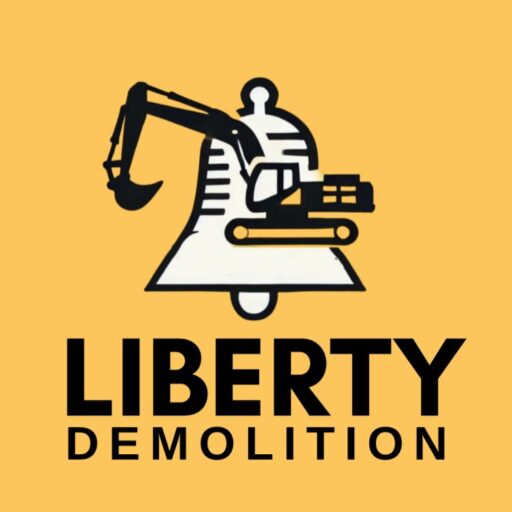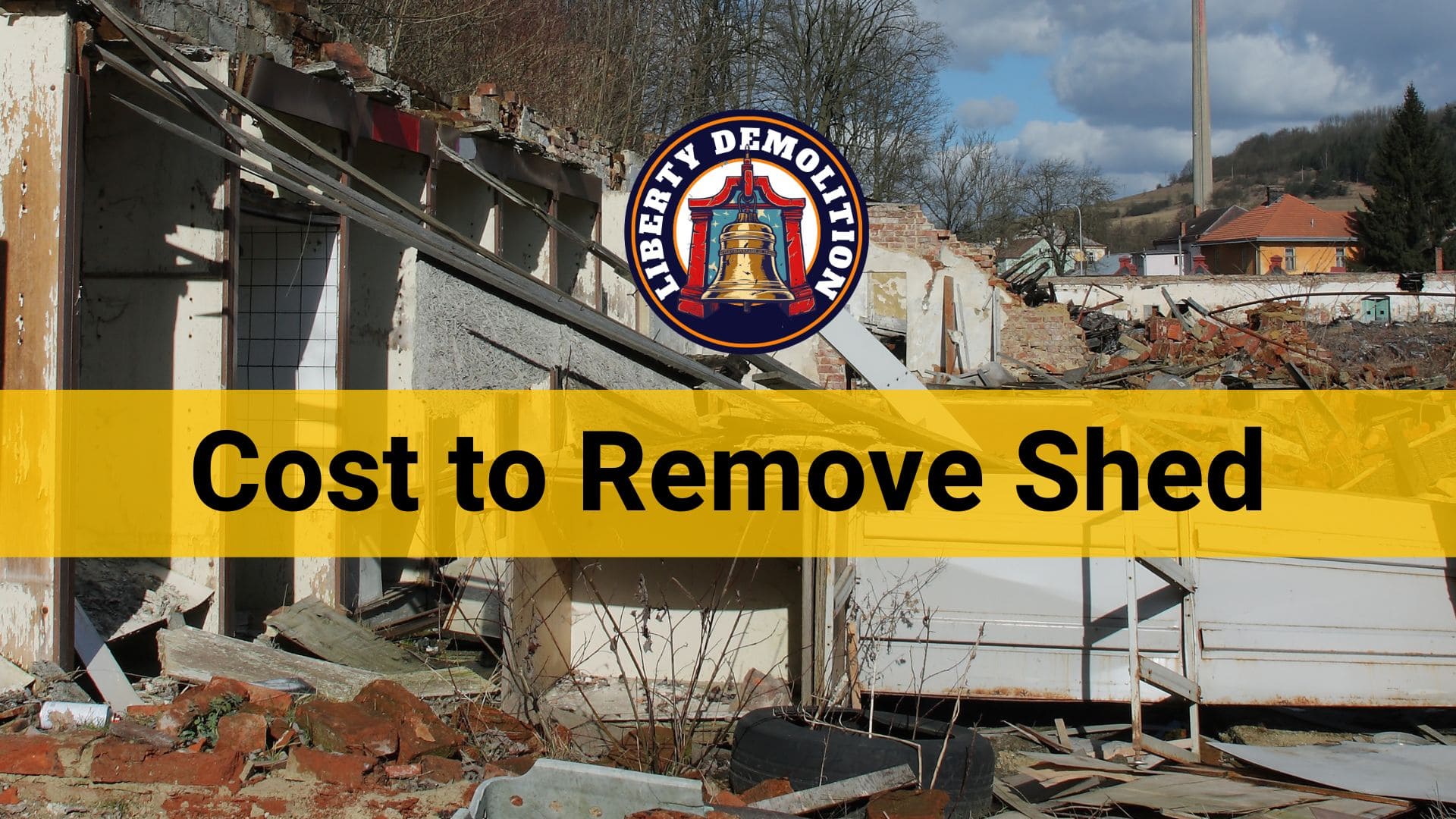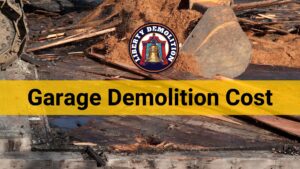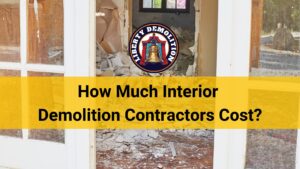The cost to remove shed averages at $650 but can range from $250 for small wooden sheds to over $3,000 for larger metal constructions with a concrete foundation. Size, material, and other factors influence the final cost.
Interested in understanding the breakdown? Keep reading to find out more.
Per-Square-Foot Pricing Range
The industry typically quotes shed removal prices in terms of per square foot. This pricing structure makes it relatively straightforward to estimate costs based on a shed’s dimensions. Costs can fluctuate between $3.50 to $11.50 per square foot, a range influenced by various factors such as accessibility, condition, and material, among others.
Impact of Different Shed Sizes on Cost
Small Sheds
These structures are less labor-intensive to dismantle. They don’t usually require specialized equipment or sizable disposal trucks. However, a notable point is that many removal companies have a minimum fee structure. So, even if your shed is petite and the cost per square foot is on the lower end, you might find yourself paying a base charge, often starting at around $250 or more.
Medium to Large Sheds
As the size grows, so does the removal cost. Larger sheds mean more material to dispose of, more time to dismantle, and often a greater need for equipment or machinery. A more massive shed could mean more workers and longer hours, which in turn raises labor costs.
Here’s a rough idea based on the general pricing range:
- Small garden tool sheds. Even if these only occupy a few square feet, you might still end up paying a base charge, often at around the $250 mark.
- Standard backyard sheds. These common structures, used for storage or as workshops, can vary widely in size. A 100-square-foot shed, for instance, could cost anywhere from $350 to $1,150, based on the per-square-foot price.
- Large storage units. The costs for these sizable structures can go up significantly, especially if they’re constructed with heavier materials or have complex features.
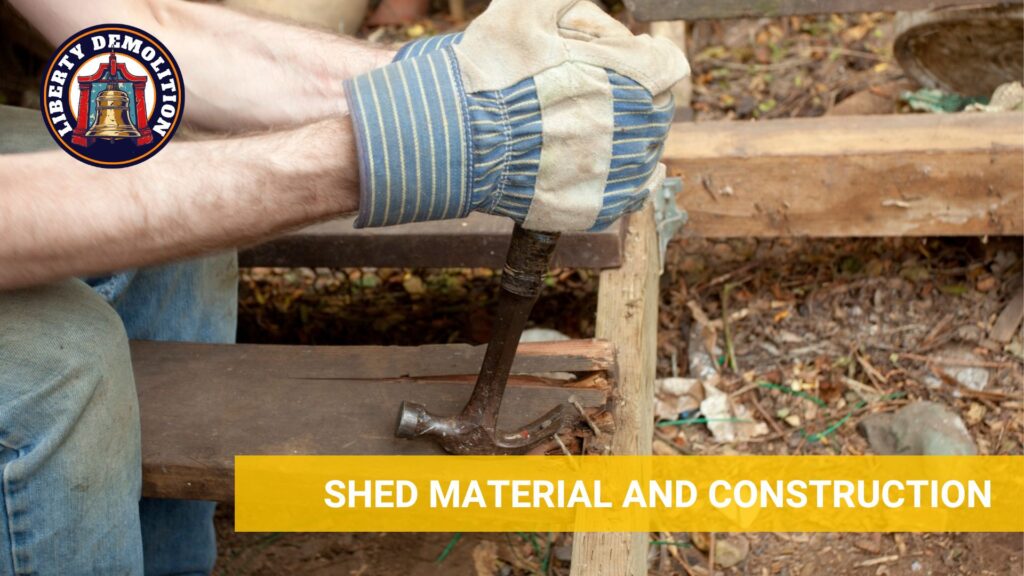
Shed Material and Construction
The material from which a shed is constructed not only determines its durability and appearance but also plays a significant role in the cost of its removal.
Wooden Sheds
Wood is a common choice for shed constructions due to its natural look and adaptability. When it comes to removal:
- Pros: Wooden sheds are often easier to dismantle, with tools and techniques readily available.
- Cons: If there’s an intent to salvage or recycle the wooden materials, costs can increase. This is because the dismantling process requires more precision and care, ensuring that the wood isn’t damaged in the process. Moreover, if the wood is rotten or has termites, additional precautions might be necessary to safely remove the shed.
Metal Sheds
These sheds, often made from sheets of aluminum or steel, offer durability and resistance to some of the common issues faced by wooden sheds. However, when it comes to their removal:
- Pros: Metal sheds, if not rusted, can sometimes be taken apart in large sections, potentially speeding up the process.
- Cons: The weight of the metal sheets can increase disposal fees. Moreover, rusty metal sheds pose challenges due to sharp, exposed edges that increase the risk of injury.
Vinyl Sheds
Made from synthetic plastic, vinyl sheds are known for their low maintenance and resistance to elements. In the context of removal:
- Pros: Vinyl sheds are relatively lightweight, which makes them easier to handle during dismantling.
- Cons: Disposal can be a concern. Some areas have specific guidelines or restrictions around the disposal of synthetic materials, which could influence disposal costs.
Construction Complexity
Beyond just the material, the construction type – whether a simple prefab unit or a complex custom-built structure – also impacts the removal cost. Prefabricated sheds, being modular in nature, are often quicker to bring down. In contrast, custom builds might have unique features or structural nuances that require more time and effort during the dismantling process.
Location and Accessibility
The location of a shed on your property is more than just an aesthetic or functional choice. When it comes time for removal, where your shed stands and how accessible it is can have direct implications on the removal costs.
Possible Additional Charges
Extended Labor Hours
As mentioned, hard-to-reach sheds often require more time to dismantle and transport. This prolonged effort can lead to higher labor charges, especially if workers are paid by the hour.
Specialized Equipment
In some instances, the standard equipment might not suffice. This will require the use of specialized tools or machinery to navigate tight spaces or handle particular challenges. Renting or using such equipment can introduce additional costs.
Restorative Work
If accessing the shed causes any wear and tear to the surrounding landscape or structures, there might be subsequent costs involved in restoration. While not a direct removal cost, it’s something homeowners should be aware of.
Labor and Hourly Rates
When it comes to the removal of structures like sheds, labor is often one of the most significant components of the cost. The pricing model adopted by removal companies or contractors varies, with some charging based on the shed’s size (square footage) and others opting for hourly rates.
Understanding Pricing Models
Square Footage Pricing
This is a common method where contractors charge based on the size of the shed. The rationale behind this approach is that larger sheds will typically require more work in terms of dismantling, hauling away materials, and overall effort. In this model:
- Rates range from approximately $3.50 to $11.50 per square foot, with the price escalating with the shed’s size.
- Some contractors might have a minimum flat-rate fee, ensuring that even smaller jobs are economically viable for them. So, even if a shed is small, the overall charge might be based on this minimum rate rather than the per-square-foot cost.
Hourly Rate Pricing
An alternative to size-based pricing, some contractors charge based on the time taken to complete the job. In this model:
- Hourly rates can vary, but they typically fall between $50 to $100 per hour. Factors like the contractor’s experience, the complexity of the job, and regional cost differences can affect this rate.
- While this method provides flexibility, it might be challenging for homeowners to estimate the total cost without a clear idea of how long the removal will take.

Factors Influencing Labor Costs
Shed’s Condition
A shed in a state of disrepair, with issues like a sagging roof or rotten framework, might require more care during dismantling, which will increase labor hours.
Special Requirements
Sheds with unique constructions or those that need specialized equipment for safe dismantling might require more skilled labor, potentially increasing the hourly rate.
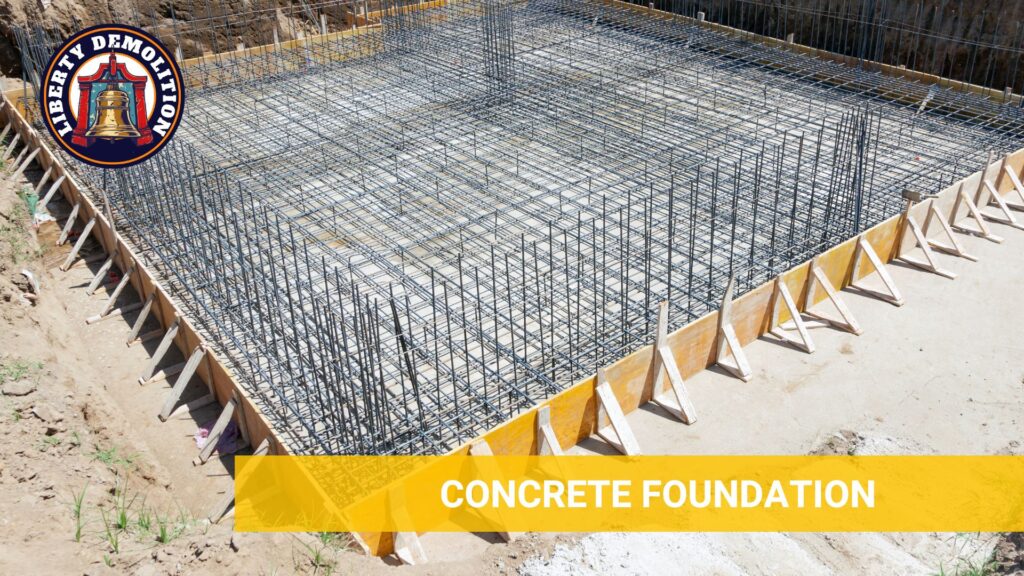
Why a Concrete Foundation Costs More to Remove?
The presence of a concrete foundation under your shed can substantially influence the cost of its removal. This solid base, while providing stability and durability to the structure, introduces a set of challenges and costs when the time comes for dismantling and removal.
Material Heaviness
Concrete is heavy. Removing a chunk of concrete involves not just breaking it down but also managing its weight during the process. This heaviness often requires specialized equipment or additional labor to ensure its safe and efficient removal.
Additional Tools Needed
Standard shed removal tools might not suffice when dealing with concrete. Contractors often need to employ powerful jackhammers, sledgehammers, or even machinery like small bulldozers to break up the concrete foundation effectively.
Increased Disposal Costs
Once broken down, the concrete chunks must be disposed of. The added weight of this material can increase disposal fees, as waste disposal sites often charge based on the weight of the material being discarded.
Safety Concerns
Concrete removal poses specific safety risks, such as flying debris and the sheer physical exertion involved. These risks might necessitate added precautions, which can, in turn, add to the cost.
Time-Intensive
Breaking up and removing a concrete foundation is a time-consuming process. Given that many contractors charge by the hour, this additional time can significantly inflate costs.
While prices can vary depending on regional factors, contractor preferences, and the specific nature of the foundation, homeowners can generally expect concrete removal costs to range from around $2 to $6 per square foot. This rate accounts for the additional labor, tools, and disposal fees specific to concrete.

Additional Expenses to Consider
Removing a shed is more than just tearing down a structure; it involves a holistic approach that takes into account various aspects of the removal process. Some costs might be immediately apparent, while others can be less obvious but equally important.
Permits
Before initiating any removal process, ensure you’re compliant with local regulations. Many states or local governments require homeowners to obtain a permit, especially for larger structures. These permits can range from $100 to $500, and sometimes more, particularly if the shed has utilities connected or sits on a concrete foundation.
Utility Disconnection
If your shed has electrical wiring, plumbing, or other utilities, it’s crucial to safely disconnect them before the removal begins. Hiring an electrician or plumber typically costs between $50 and $100 per hour. Ensuring utilities are appropriately disconnected prevents potential accidents and ensures the safety of the removal crew.
Asbestos Concerns
If there’s any suspicion, an inspection is essential. Asbestos removal for outdoor projects can range from $50 to $150 per square foot. This is not a step to skip, given the health risks associated with asbestos.
Landscaping
After your shed has been removed, you might be left with an area that needs landscaping attention. Depending on the state of the ground post-removal, leveling, sodding, or planting might be necessary. Professional landscaping generally costs between $4.50 and $12 per square foot, but this provides an opportunity to rejuvenate and utilize the space optimally.
Shed Contents Removal
If your shed has accumulated a lot of items over the years, the cost of clearing it out can add up. While some removal companies might offer this service, they could require a larger dumpster or additional time, which comes with its own set of fees.
Shed Removal Permits
When it comes to the removal of backyard structures like sheds, adhering to local regulations and rules is essential. Beyond ensuring a safe and organized removal process, it’s crucial from a legal perspective to ensure all the steps are appropriately managed.
Why Are Permits Necessary?
Building and zoning departments in municipalities have regulations to ensure that property owners undertake construction or demolition tasks safely and in a manner that does not negatively impact the community or environment. Sheds, despite their seemingly simple nature, are considered structures. Removing them, especially if they are large, can involve safety risks, potential utility disconnections, and waste disposal requirements that the local government needs to oversee.
For larger sheds, the necessity of a permit becomes even more pronounced. These structures might have been wired for electricity, connected to water, or built on concrete foundations. Their removal is not just about dismantling walls and roofs but also ensuring utilities are properly disconnected, foundation removal doesn’t negatively affect surrounding property, and waste is properly disposed of.
Estimated Cost for Permits
The cost of obtaining a shed removal permit can vary depending on the size of the shed, its location, and specific local regulations. On average, homeowners might find themselves spending anywhere from $100 to $500 for the permit. However, it’s important to check with your local building department to get an exact figure. Some larger sheds, especially those with utilities and concrete foundations, might command higher permit fees due to the complexity of the removal process.
Weighing the DIY Option
At first glance, a DIY shed removal might seem more cost-effective. Yet, even when removing the shed yourself, there are costs to consider:
Junk Removal
Depending on the shed’s size and the debris created, you may need a junk removal service to haul away the waste. The average cost for junk removal hovers around $240, but this can vary based on your location and the volume of junk.
Dumpster Rental
An alternative to hiring a junk removal service is renting a dumpster. This is especially practical if you anticipate a lot of debris. The average cost for a week’s rental is about $380. However, some companies might offer daily rates, which could be more cost-effective for shorter projects.
Tools & Equipment
You’ll need the right tools to safely dismantle the shed. Depending on your current tool collection, you might need to purchase or rent additional equipment.
Safety
DIY shed removal comes with its risks. Without proper knowledge and experience, there’s potential for injury, especially with larger or older sheds. It’s crucial to have safety gear and be aware of best practices.
Time
Time is another resource to consider. Depending on the shed’s size and complexity, removal could take anywhere from a few hours to multiple days.
Removing a shed may initially seem like a simple task, especially if you’re a homeowner accustomed to tackling DIY projects. However, shed removal is more complex than it might first appear. It requires specialized tools, knowledge, and, often, a team effort. This is where the expertise of professionals becomes invaluable.

FAQs About the Cost to Remove Shed
When is the right time to remove a shed?
The best time to remove a shed often depends on individual circumstances. Some indicators include:
- Safety Concerns. If your shed is leaning, has rotten foundations, or exhibits structural weaknesses, it might be time for removal.
- Aesthetic Reasons. An old, worn-out shed can be an eyesore and diminish the overall appeal of your property.
- Space Needs. If you’re redesigning your garden or backyard and need the space occupied by the shed, removal becomes necessary.
- Regulatory Reasons. Sometimes, local building codes or homeowner association rules might necessitate the removal of non-compliant structures.
How long does it typically take to dismantle a shed?
The duration required to dismantle a shed can vary based on several factors:
- Shed Size. Naturally, larger sheds will take longer to dismantle than smaller ones.
- Materials Used. Some materials, like metal or reinforced concrete, may take longer to dismantle than wood or vinyl.
- Access and Location. A shed situated in a hard-to-reach location or surrounded by other structures might require extra time for safe dismantling.
- Foundation Type. A shed with a concrete foundation will add to the removal time due to the added complexity of breaking and removing the concrete.
Typically, for an average-sized wooden shed in a reasonably accessible location, dismantling could take a day or two. However, it’s always best to consult with professionals for an accurate estimate.
What can I do with my old shed once it’s dismantled?
Post-removal, homeowners have several options for their old sheds, such as repurposing, recycling, selling, donating, or disposing of properly.
Your Next Steps in Shed Removal
Understanding the factors that influence the cost of shed removal is crucial for homeowners looking to make informed decisions. From the materials used in the shed’s construction to its location and size, several elements play a part in determining the overall expenses. Additionally, while DIY options might seem enticing, the value of professional services cannot be overstated, both in terms of safety and efficiency.
For those seeking an eco-conscious and expert approach to shed removal, we’re here to help. We at Liberty Demolition have an extensive portfolio covering residential, commercial, industrial, and selective demolition. Moreover, our commitment to efficient waste management and recycling ensures that your demolition needs are not only met but done so in a way that respects our planet and its resources.
If you’re contemplating a shed removal or any other demolition task, reach out to Liberty Demolition. Our team of professional demolition contractors is always ready to tackle demolition projects, big or small. Call us now for a free quote.
